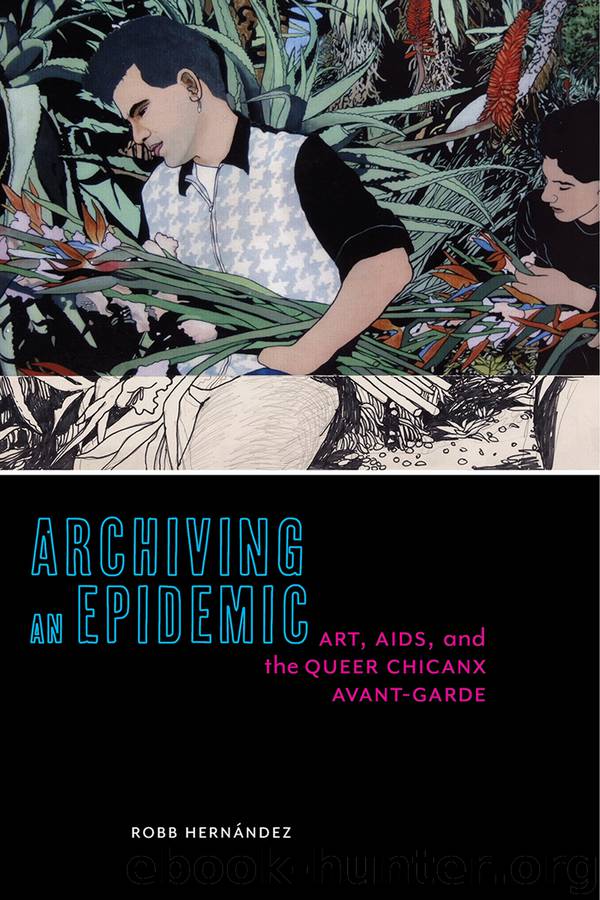Archiving an Epidemic by Robb Hernández

Author:Robb Hernández
Language: eng
Format: epub
Publisher: NYU Press
Figure 4.1. Joey Terrill, Four Men I Could Have Asked to Marry Me (2015), acrylic painting. Photograph courtesy of the artist.
More than an analysis of Terrill’s alternative archival practices and his creative antecedents, this chapter also unfurls the vital relationship between the artist, archive, collector, and home interior. Rather than enter a familiar collection studies discourse with a penchant for social capital analysis and the discerning eye of elite taste cultures, I expose another area not yet explored in this study: Chicanx collecting practices reformed around historic and contemporary signifiers of same-sex desire and contagion.9 As gay human geographer Andrew Gorman-Murray suggests, “While home continues to be understood as a site of self-construction, it is no longer seen as a fixed unchanging space which ‘stores’ traditional values.… Home is a constant state of becoming, remade over and over again through processes called homemaking.”10 Producing the “fantasmatic space of homosexuality,” as Richard Meyer terms Robert Mapplethorpe’s remodeled living space with its sexually charged furnishings often quoted in his oeuvre, queer collectors make home and in turn “construct” the self with Terrill’s speculative ruminations on life pre- and post-infection.
This process of domesticating a virus breaks down the distance between collectors, interior space, and the object. Living with the material approximation of a plague is cause for a more nuanced understanding of the home display or what I term “para-site.” Chicanx interiors perform “a critical act of witness[ing] to the historic and ongoing institutional violence that continues to push Mexicans and Mexican Americans into marginalized social positions,” as Karen Mary Davalos notes.11 Versatile in what Gérard Genette terms “paratexts”—the anterior and posterior temporal structures of the book’s narrative space, editorial logics, and textual transactions—para-sites upend the timely rhythms of domestic architecture’s beginnings and ends.12 Like the Greek etymology of the term, meaning “near, alongside and beyond,” the incomplete closures of time in the para-site confronts not only ethnoracial resistance to systemic institutional violence, as Davalos argues (after all, these are Chicanx artworks marginalized in an elite US art marketplace) but also the way works imbued by HIV transmit an infectious visual knowledge with the pacing of deathly urgency, of faltering immune systems, of pharmaceutical unknowns, of human crises. Queer Chicanx men shape these households by playing host to these citations of HIV transmission and, in turn, plot their homes with Terrill’s archival body, a body traced by infection, his own and others.
This chapter begins by discerning the archival precepts for Terrill’s queer visual testimonio approach, which germinates out of Chicana and Chicano movement activism, gay and lesbian liberation, and queer Chicanx avant-garde practices in the 1970s. I argue that his alternative archivality, a reversal of a compulsory heterosexual Chicano reality, pervades his visual lexicon prior to 1989, the year he tests positive for HIV. Then, by emphasizing the paintings he generated after his diagnosis, I elucidate how seroconversion—the delayed time between initial infection and HIV diagnosis—is visually conveyed in scenic vignettes that depict how he and his raucous cohort, the “Escandalosa Circle,” experience a queer brown world waning in the time of AIDS.
Download
This site does not store any files on its server. We only index and link to content provided by other sites. Please contact the content providers to delete copyright contents if any and email us, we'll remove relevant links or contents immediately.
The Secret History by Donna Tartt(18843)
The Social Justice Warrior Handbook by Lisa De Pasquale(12141)
Thirteen Reasons Why by Jay Asher(8792)
This Is How You Lose Her by Junot Diaz(6794)
Weapons of Math Destruction by Cathy O'Neil(6142)
Zero to One by Peter Thiel(5685)
Beartown by Fredrik Backman(5596)
The Myth of the Strong Leader by Archie Brown(5425)
The Fire Next Time by James Baldwin(5248)
How Democracies Die by Steven Levitsky & Daniel Ziblatt(5127)
Promise Me, Dad by Joe Biden(5087)
Stone's Rules by Roger Stone(5026)
A Higher Loyalty: Truth, Lies, and Leadership by James Comey(4843)
100 Deadly Skills by Clint Emerson(4840)
Rise and Kill First by Ronen Bergman(4701)
Secrecy World by Jake Bernstein(4644)
The David Icke Guide to the Global Conspiracy (and how to end it) by David Icke(4624)
The Farm by Tom Rob Smith(4434)
The Doomsday Machine by Daniel Ellsberg(4415)
